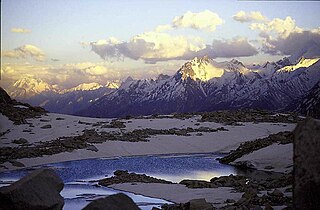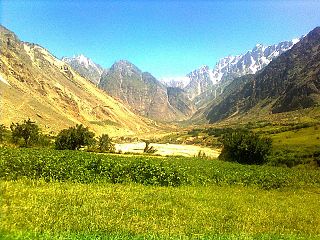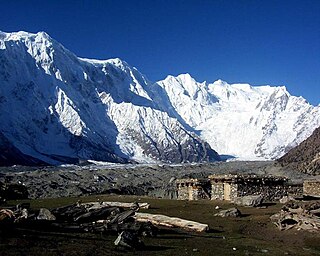
The Karakoram is a mountain range in the Kashmir region spanning the border of Pakistan, China, and India, with the northwestern extremity of the range extending to Afghanistan and Tajikistan. Most of the Karakoram mountain range falls under the jurisdiction of Gilgit-Baltistan, which is controlled by Pakistan. Its highest peak, K2, is located in Gilgit-Baltistan. It begins in the Wakhan Corridor (Afghanistan) in the west, encompasses the majority of Gilgit-Baltistan, and extends into Ladakh and Aksai Chin.

Count Ardito Desio was an Italian explorer, mountain climber, geologist, and cartographer.

Skardu is a city located in Pakistan-administered Gilgit-Baltistan in the disputed Kashmir region. Skardu serves as the capital of Skardu District and the Baltistan Division. It is situated at an average elevation of nearly 2,500 metres above sea level in the Skardu Valley, at the confluence of the Indus and Shigar rivers. The city is an important gateway to the eight-thousanders of the nearby Karakoram mountain range. The Indus River running through the region separates the Karakoram from the Ladakh Range.

Borith Lake is a lake in the Hunza Valley in the Gilgit–Baltistan region of northern Pakistan. Borith lies about 2,600 metres (8,500 ft) above sea level.

Northern Pakistan is a tourism region in northern and north-western parts of Pakistan, comprising the administrative units of Gilgit-Baltistan, Azad Kashmir, Khyber Pakhtunkhwa, Islamabad Capital Territory and the Rawalpindi Division in Punjab. The first two territories are a part of the wider Kashmir region. It is a mountainous region straddling the Himalayas, Karakoram and the Hindu Kush mountain ranges, containing many of the highest peaks in the world and some of the longest glaciers outside polar regions. Northern Pakistan accounts for a high level of Pakistan's tourism industry.

The Mintaka Pass or Mingteke Pass or Mintika Pass(Chinese: 明铁盖达坂) is a mountain pass in the Karakorum Mountains, between northern Pakistan and Xinjiang in China. In ancient times, the Mintaka Pass and the nearby Kilik Pass, 30 km (19 mi) to the west, were the two main access points into Gojal from the north. The Hunza Valley is a mountainous valley near Gilgit in the Gilgit-Baltistan region of Pakistan. In addition, the two passes were also the routes used to reach Chalachigu Valley and Taghdumbash Pamir from the south. The name of the pass – Mintaka means "a thousand ibex" in Kyrgyz.

The Kilik Pass to the west of Mintaka Pass is a high mountain pass in the Karakorum Mountains between Gilgit-Baltistan in Pakistan and Xinjiang in China. The two passes were, in ancient times, the two main access points into the Upper Hunza Valley from the north. In addition, the two passes were also the paths used to reach Chalachigu Valley and Taghdumbash Pamir from the south.

Malubiting, also known as Malubiting West, ranks as the second highest peak is between Haramosh and Hisper valley within the Karakoram range in Pakistan. It is situated between Bilchar Dobani and Haramosh Peak, in the Gilgit-Baltistan region. Hisper Valley Nagar

The Rakaposhi-Haramosh Mountains are a subrange of the Karakoram range. They are located in the Bagrot Valley Gilgit and Nagar Districts, in the Gilgit-Baltistan of Pakistan.

The Spantik-Sosbun Mountains are a sub range of the Karakoram range in Gilgit-Baltistan, Pakistan.
Balghar is a village situated in Ghanche, Gilgit Baltistan, Pakistan, along the banks of the Shyok River. The confluence of the Shyok River and the Indus River occurs approximately 30 kilometers to the west of Balghar, near Keris کریس. Balghar encompasses 15 distinct neighborhoods (mahallahs), both large and small, namely Gond Balghar, Chan Gond Balghar, Chopya, Rotaka, Ongbo, Marmoung Balghar, Loda Balghar, Khanka Grwong Balghar, Khodakha Balghar, Gareippa Balghar, Krawathang Balghar, Khashu Balghar, Gamba Bordas Balghar, Yompowa Balghar, and Xooq Balghar. To the east lies the House Valley, while the Karis Valley is located to the west, Shiger Valley to the north, and Daghoni/Balghar to the south.

The Braldu River flows in the Skardu District of Gilgit Baltistan in Pakistan. The Braldu River joins the Basha Basna River, and together they form the Shigar River, which is a tributary of the Indus River.

Jenny Visser-Hooft was a Dutch traveler, mountaineer, and writer known for the flora and fauna research she did in the 1920s with her husband, Philips Christiaan Visser, in Pakistan and India's Karakorum Glaciers region.

Kutiah Lungma Glacier is a glacier that stretches for approximately 12 km in length and has a width of about 3 km. It is situated within the Karakoram mountain range in the Stak Valley of District Skardu, Gilgit-Baltistan, Pakistan. This glacier is located in the Stak Valley, which is sometimes referred to as Staq, and it falls within the subdivision of Roundu in district Skardu, Gilgit-Baltistan.

Stak Valley is a valley in the Roundu Subdivision of District Skardu, in the Gilgit-Balitistan territory of Pakistan-administered Kashmir. The valley is on the right bank of the Indus River, between the cities of Skardu and Giligit. The valley is the biggest valley in term of area and population in Roundu subdivision. The valley has been one of the very important regions of the area in term of in history and of geological formation as well.
Paraber Peak is a peak in Stak Valley of Gilgit-Baltistan. This mountain is located in the Karakoram range and the prominent landmarks in the vicinity are Haramosh Peak, Laila Peak, Kutia Lungma Glacier and the Chogo Lungma Glacier.

Muchu Chhish is a mountain in the Batura Muztagh sub-range of the Karakoram in Hunza Valley, in northern areas of Pakistan. Located in a very remote and inaccessible region, only a handful of attempts have been made to reach the summit; and none have succeeded. Muchu Chhish is one of the tallest mountains on Earth that remains unclimbed, and the tallest one of all that is not off limits due to religious or political prohibitions. The peak has a modest prominence however, rising only 263 m (863 ft) above the nearest col or pass. The Batura Glacier, one of the longest outside the polar regions, flanks Muchu Chhish to the north.

















